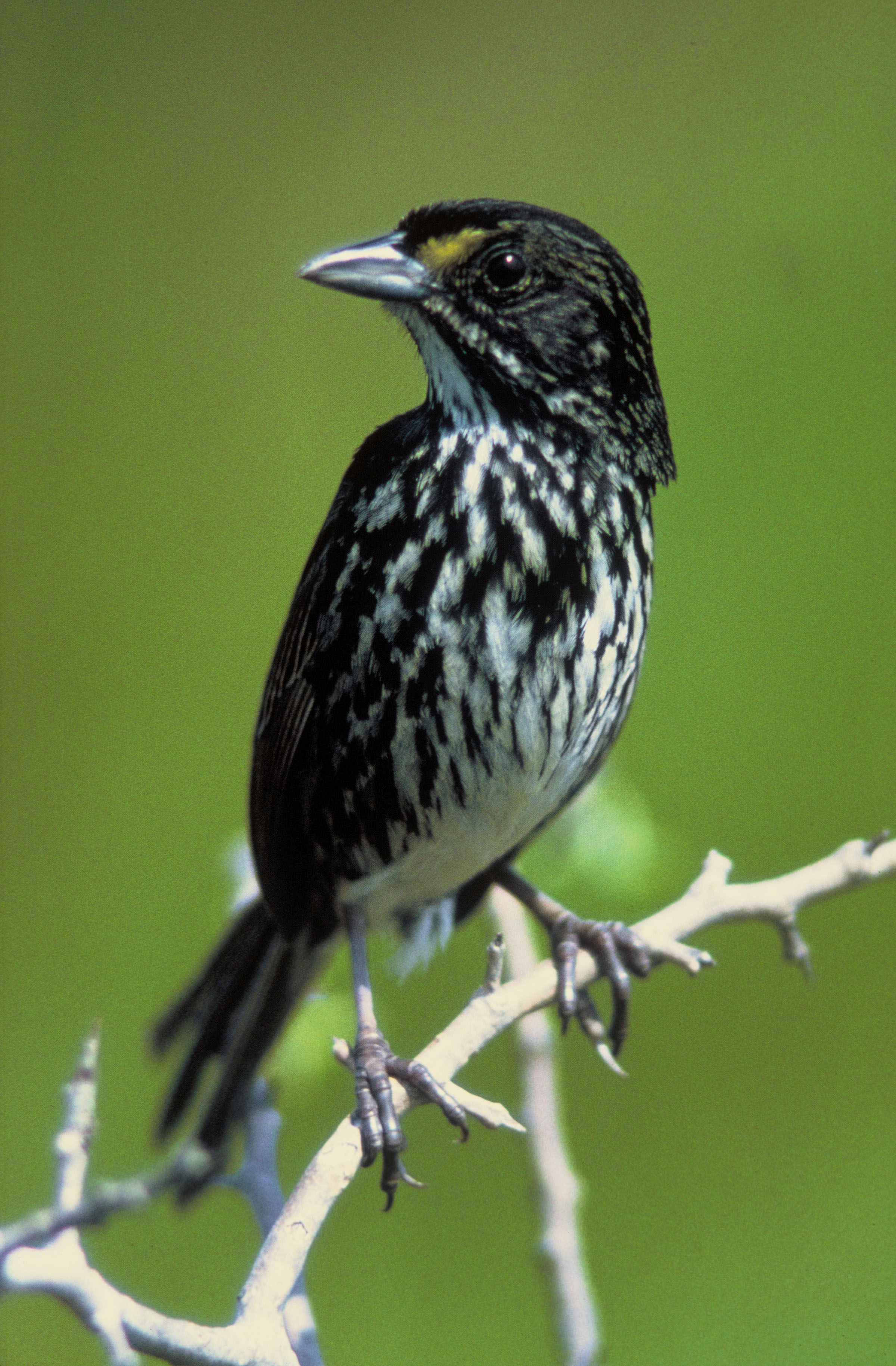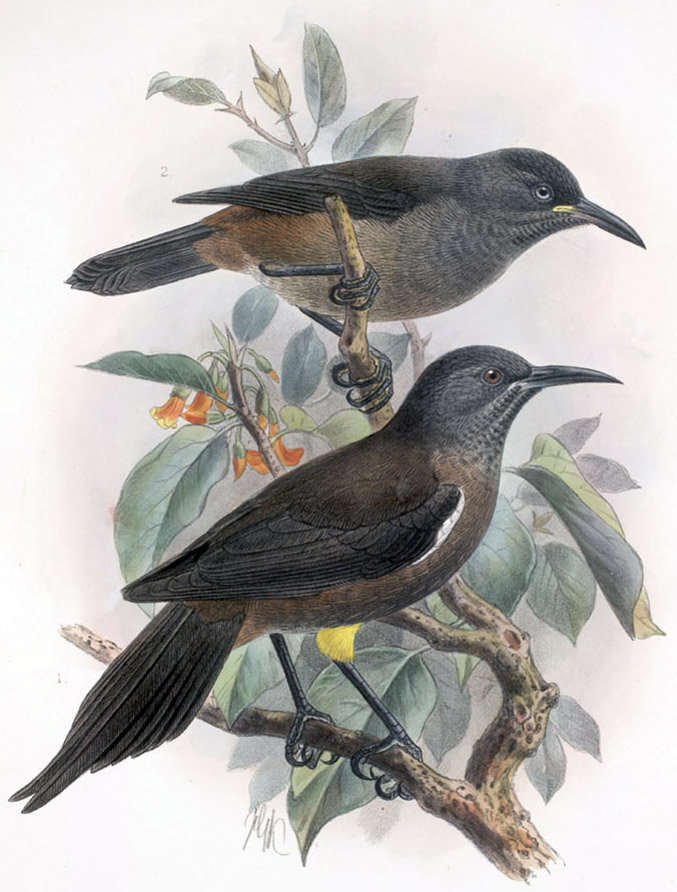|
Endlings
An endling is the last known individual of a species or subspecies. Once the endling dies, the species becomes extinct. The word was coined in correspondence in the scientific journal ''Nature (journal), Nature''. Usage The 4 April 1996 issue of ''Nature (journal), Nature'' published a correspondence in which commentators suggested that a new word, ''endling'', be adopted to denote the last individual of a species. The 23 May issue of ''Nature'' published several counter-suggestions, including ''ender'', ''terminarch'', and ''relict''. The word ''endling'' appeared on the walls of the National Museum of Australia in ''Tangled Destinies'', a 2001 exhibition by Matt Kirchman and Scott Guerin, about the relationship between Australian peoples and their land. In the exhibition, the definition, as it appeared in Nature, was printed in large letters on the wall above two specimens of the extinct thylacine, Tasmanian tiger: "Endling (n.) The last surviving individual of a species o ... [...More Info...] [...Related Items...] OR: [Wikipedia] [Google] [Baidu] |
Thylacine
The thylacine (; binomial name ''Thylacinus cynocephalus''), also commonly known as the Tasmanian tiger or Tasmanian wolf, was a carnivorous marsupial that was native to the Mainland Australia, Australian mainland and the islands of Tasmania and New Guinea. The thylacine died out in New Guinea and mainland Australia around 3,600–3,200 years ago, prior to the arrival of Europeans, possibly because of the introduction of the dingo, whose earliest record dates to around the same time, but which never reached Tasmania. Prior to European settlement, around 5,000 remained in the wild on the island of Tasmania. Beginning in the nineteenth century, they were perceived as a threat to the livestock of farmers and bounty (reward), bounty hunting was introduced. The last known of its species died in 1936 at Hobart Zoo in Tasmania. The thylacine is widespread in popular culture and is a cultural icon in Australia. The thylacine was known as the Tasmanian tiger because of the dark trans ... [...More Info...] [...Related Items...] OR: [Wikipedia] [Google] [Baidu] |
Incas (Carolina Parakeet)
Incas (before 1885 – February 21, 1918) was a male Carolina parakeet and the last member of his species known with certainty. Though probable sightings of wild Carolina parakeets continued into the 1930s, and the American Ornithologists Union accepted a sighting in 1920, no specimens were collected after 1904 and he is often cited as the last individual in existence. Incas died in the Cincinnati Zoo in 1918, in the same enclosure as Martha, the last passenger pigeon, who died in 1914. He died within one year of his mate, Lady Jane. Background The Carolina parakeet was the only parrot species historically native to eastern North America and was documented to be plentiful in early accounts. Over the centuries following European colonization of the Americas, a combination of factors including collection for hat feathers, the pet trade, and eradication by farmers due to their reputation as crop predators led the Carolina parakeet to become increasingly rare by the mi ... [...More Info...] [...Related Items...] OR: [Wikipedia] [Google] [Baidu] |
Martha (pigeon)
Martha ( – September 1, 1914) was a passenger pigeon, the last known of her species; she was named "Martha" in honor of Martha Washington, the first lady of the United States from 1789 to 1797. Early life The history of the Cincinnati Zoo's passenger pigeons has been described by Arlie William Schorger in his monograph on the species as "hopelessly confused," and he also said that it is "difficult to find a more garbled history" than that of Martha. The generally accepted version is that, by the turn of the 20th century, the last known group of passenger pigeons was kept by Professor Charles Otis Whitman at the University of Chicago. Whitman originally acquired his passenger pigeons from David Whittaker of Wisconsin, who sent him six birds, two of which later bred and hatched Martha in about 1885. Martha was named in honor of Martha Washington. Whitman kept these pigeons to study their behavior, along with rock doves and Eurasian collared-doves. Whitman and the Cincin ... [...More Info...] [...Related Items...] OR: [Wikipedia] [Google] [Baidu] |
Kauaʻi ʻōʻō
The Kauaʻi ʻōʻō () or ''ʻōʻōʻāʻā'' (''Moho braccatus'') was the last member of the ʻōʻō (''Moho (genus), Moho'') genus within the Mohoidae family of birds from the islands of Hawaii, Hawaiʻi. The entire family is now Extinction, extinct. It was previously regarded as a member of the Australo-Pacific honeyeaters (Family (biology), family Honeyeater, Meliphagidae). The bird was Endemism, endemic to the island of Kauai, Kauaʻi. It was common in the subtropical forests of the island until the early twentieth century, when its decline began. It was last seen in 1985, and last heard in 1987. The causes of its extinction include the introduction of predators (such as the Polynesian rat, small Indian mongoose, and the domestic pig), mosquito-borne diseases, and habitat destruction. It was the last surviving member of the Mohoidae, which had originated over 15-20 million years previously during the Miocene, with the Kauaʻi ʻōʻō's extinction marking the only exti ... [...More Info...] [...Related Items...] OR: [Wikipedia] [Google] [Baidu] |
Discovery Island (Bay Lake)
Discovery Island is an island in Bay Lake, Florida. It is located on the property of Walt Disney World in the city of Bay Lake. Between 1974 and 1999, it was an attraction open to guests, who could observe its many species of animals. Disney originally named it ''Treasure Island'', and later renamed it ''Discovery Island''. It currently sits abandoned, but can be seen by any watercraft in Bay Lake. Discovery Island is now the name of one of the lands in Disney's Animal Kingdom. History Origins From 1900 to 1937, the island was known as Raz Island, named after the family that lived there. In the late 1930s, it was purchased for $800 by a man named Delmar "Radio Nick" Nicholson, who renamed it "Idle Bay Isle" and lived there for 20 years with his wife and pet crane. It was later sold, after the island's owner became ill, and renamed "Riles Island," and used as a hunting retreat. Disney bought it in 1965 as part of its strategic property acquisitions before building the Walt ... [...More Info...] [...Related Items...] OR: [Wikipedia] [Google] [Baidu] |
Walt Disney World Resort
The Walt Disney World Resort is an entertainment resort complex located about southwest of Orlando, Florida, United States. Opened on October 1, 1971, the resort is operated by Disney Experiences, a division of the Walt Disney Company. The property covers nearly , of which half has been developed. Walt Disney World contains numerous recreational facilities designed to attract visitors for an extended stay, including four theme parks, two water parks, four golf courses, conference centers, a competitive sports complex and a shopping, dining and entertainment complex. Additionally, there are 19 Disney-owned resort hotels and one camping resort on the property, and many other non-Disney-operated resorts on and near the property. Designed to supplement Disneyland in Anaheim, California, which had opened in 1955, the complex was developed by Walt Disney in the 1960s. Walt wanted to build a new park because Disneyland in California was limited from expanding by the establishme ... [...More Info...] [...Related Items...] OR: [Wikipedia] [Google] [Baidu] |
Associated Press
The Associated Press (AP) is an American not-for-profit organization, not-for-profit news agency headquartered in New York City. Founded in 1846, it operates as a cooperative, unincorporated association, and produces news reports that are distributed to its members, major U.S. daily newspapers and radio and television broadcasters. Since the award was established in 1917, the AP has earned 59 Pulitzer Prizes, including 36 for photography. The AP is also known for its widely used ''AP Stylebook'', its AP polls tracking National Collegiate Athletic Association, NCAA sports, sponsoring the National Football League's annual awards, and its election polls and results during Elections in the United States, US elections. By 2016, news collected by the AP was published and republished by more than 1,300 newspapers and broadcasters. The AP operates 235 news bureaus in 94 countries, and publishes in English, Spanish, and Arabic. It also operates the AP Radio Network, which provides twice ... [...More Info...] [...Related Items...] OR: [Wikipedia] [Google] [Baidu] |
David Boynton
David Boynton (August 30, 1945 – February 10, 2007) was a leading expert on the natural history of the Hawaiian island of Kauai, especially on the Koke'e Forest and the Alakai Swamp and its wildlife. He was called "a voice for the Hawaiian wilderness," a "Guardian of the Koke'e Forest," and as an educator, "the window through which thousands of Hawai'i students learned about Hawaiian birds, plants, marine creatures, climate and much more." Boynton photographed a bird now believed extinct, the Ōōāā ('' Moho braccatus''). He recorded the mating call of the single male, whose mate presumably did not survive Hurricane Iwa at the end of 1987. The bird, probably the last of its species, was tending an empty nest. Boynton used this poignant recording and story to inspire Hawaiian school children in the traditional Hawaiian values of kuleana, malama, kokua, laulima, ho'ihi, lokahi, and pono, which translate roughly as rights and responsibilities to the land, the appropriateness ... [...More Info...] [...Related Items...] OR: [Wikipedia] [Google] [Baidu] |
Kauai
Kauai (), anglicized as Kauai ( or ), is one of the main Hawaiian Islands. It has an area of 562.3 square miles (1,456.4 km2), making it the fourth-largest of the islands and the 21st-largest island in the United States. Kauai lies 73 miles (117 km) northwest of Oahu, across the Kauai Channel. The island's 2020 population was 73,298. Styling itself the "Garden Isle", Kauai is the site of Waimea Canyon State Park and Nā Pali Coast State Park. It forms the bulk of Kauai County, which includes Niihau as well as the small nearby islands of Kaula and Lehua. Etymology and language Hawaiian narrative derives the name's origin from the legend of Hawaiiloa, the Polynesian navigator credited with discovering the Hawaiian Islands. The story relates that he named the island after a favorite son; a possible translation of Kauai is "place around the neck", describing how a father would carry his child. Another possible translation is "food season". Kauai was known for its ... [...More Info...] [...Related Items...] OR: [Wikipedia] [Google] [Baidu] |
Martha's Vineyard
Martha's Vineyard, often simply called the Vineyard, is an island in the U.S. state of Massachusetts, lying just south of Cape Cod. It is known for being a popular, affluent summer colony, and includes the smaller peninsula Chappaquiddick Island. It is the List of islands of the United States by area, 58th largest island in the U.S., with a land area of about , and the third-largest on the East Coast of the United States, East Coast, after Long Island and Mount Desert Island. Martha's Vineyard constitutes the bulk of Dukes County, Massachusetts, which also includes the Elizabeth Islands and the island of Nomans Land (Massachusetts), Nomans Land. The island's year-round population has considerably increased since the 1960s. In the 2023 Martha's Vineyard Commission report, the year-round population was 20,530, an increase from 16,460 in 2010. The summer population swells to more than 200,000 people. About 56 percent of the Vineyard's 14,621 homes are seasonally occupied. A stud ... [...More Info...] [...Related Items...] OR: [Wikipedia] [Google] [Baidu] |
Hurricane Iniki
Hurricane Iniki ( ; Hawaiian: ''iniki'' meaning "strong and piercing wind") was a hurricane that struck the island of Kauai on September 11, 1992. It was the most powerful hurricane to strike Hawaii in recorded history, and the only hurricane to directly affect the state during the 1992 Pacific hurricane season. Forming on September 5, 1992, it was the first hurricane to hit the state since Hurricane Iwa in the 1982 season, and the only known major hurricane to hit the state. Iniki dissipated on September 13, about halfway between Hawaii and Alaska. Iniki caused around $3.1 billion (equivalent to $ billion in ) in damage and seven deaths. This made Iniki, at the time, the costliest natural disaster on record in the state, as well as the third-costliest to hit the U.S. It struck just 18 days after Florida was devastated by Hurricane Andrew, which was the costliest tropical cyclone ever at the time. The Central Pacific Hurricane Center (CPHC) failed to issue tropic ... [...More Info...] [...Related Items...] OR: [Wikipedia] [Google] [Baidu] |







